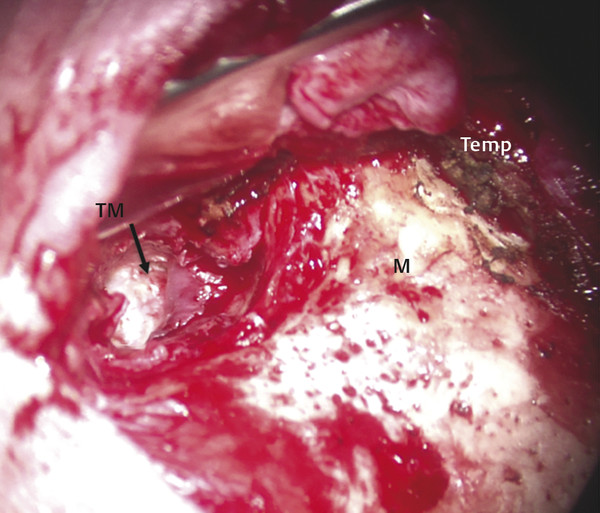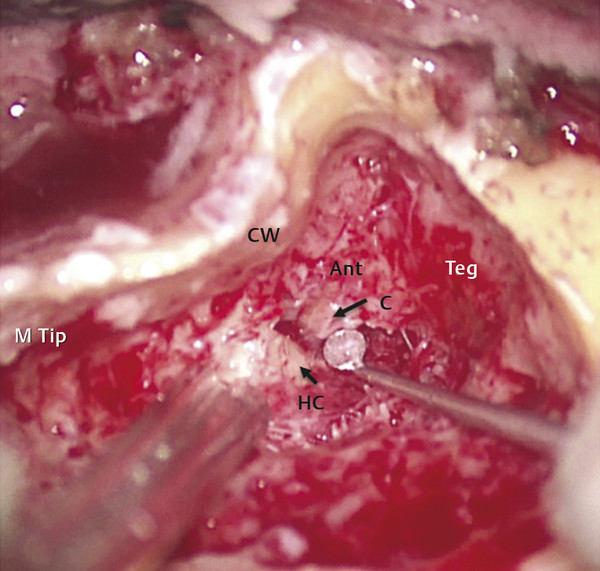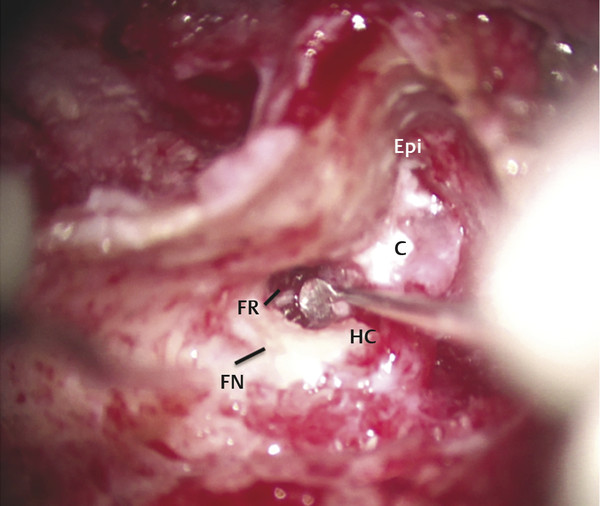Variations of the mastoidectomy procedure are a prerequisite for the management of chronic ear disease. The canal wall-up (CWU, also known as intact–canal wall [ICW] or combined approach) mastoidectomy has been the mainstay of chronic ear management for the last 50 years. The CWU mastoidectomy preserves the posterior bony canal and reconstructs any canal defects with cartilage or autologous bone grafts. Historically, the CWU mastoidectomy accounts for 70% of mastoidectomy procedures performed for chronic ear disease.1,2 This proportion is even higher in children with cholesteatoma.3,4,5
For centuries the role of mastoidectomy was limited to decompression for acute mastoiditis. The 18th century French surgeon Jean-Louis Petit (1674–1750) documented multiple mastoid trephinations in which he actively sought purulence before the infection developed its fatal intracranial sequelae.6,7 Over the next 100 years, the operation was fraught with mixed results, often from questionable surgical indications and lack of specific technique. Anton Fredrich von Tröltsch (1829–1890) critically reviewed patient selection and laid the foundation for his protégée, Hermann Schwartze (1837–1910), to describe the surgical steps of a simple mastoidectomy with antrostomy.6,8
The “Schwartze” mastoidectomy sufficed for acute mastoiditis, but more extensive pneumatization was necessary for management of chronic ear disorders. Emanuel Zaufal (1837–1910) and Ludwig Stacke (1859–1918) in the 1890s introduced the radical mastoidectomy.6,9 This technique and its demolition of the middle ear space left many patients with worse hearing and persistent otorrhea. Gustave Bondy (1870–1954) in 1910 popularized the modified radical mastoidectomy.6,10 Bondy’s insight that attic cholesteatomas could be exteriorized while preserving the ossicles and the pars tensa was a breakthrough in hearing preservation.
The radical and modified radical mastoidectomies were the mainstay of otologic surgery until the introduction of the otologic microscope and tympanoplasty techniques by Horst Wullstein (1906–1987) and F. Zollner in the 1950s.11,12 Still, problems with reduced middle ear space and a damp environment often led to graft failure and poor hearing. This prompted William House (1923–2012), James Sheehy (1926–2006), and others to develop a procedure that preserved the natural position of the tympanic membrane and avoided the morbidity of a mastoid cavity. In 1963 the importance of an intact canal wall, development of the facial recess approach, and use of plastic sheeting to control adhesions led to the modern CWU mastoidectomy that remains largely unchanged today.13
33.2 Patient Selection
The most common indication for CWU mastoidectomy is management of chronic otitis media with or without cholesteatoma. The additional steps of opening the facial recess, extended facial recess, or lateral epitympanotomy allow disease to be eradicated from much of the mastoid and middle ear spaces. Whereas the decision to keep the canal wall intact often necessitates a “second look” on account of a higher recidivism rate, the benefit of less perioperative complications, less long-term maintenance, and improved hearing results are significant.2,14,15,16 Additionally, the CWU method has been the procedure of choice for children to avoid the life-long morbidity of an open cavity.4
Access to the round window via the facial recess makes the CWU mastoidectomy an intricate part of cochlear implantation. Skeletonization of the vertical segment of the facial nerve, tegmen mastoideum, and tegmen tympani may facilitate repair of a facial nerve injury or encephalocele.16,17 Mastoidectomy has been used for tympanoplasty with the notion that a well-aerated mastoid cavity will improve graft viability and hearing results. Recent reviews have not supported a global improvement in tympanoplasty results with mastoidectomy.18 The senior authors still include a mastoidectomy as part of the tympanoplasty if the ear is fraught with chronic disease or otorrhea or if there is concern for cholesteatoma.
When House, Sheehy, and others first described the CWU mastoidectomy, they did so with the understanding that an obligatory second procedure 6–12 months after the original operation, termed a “second-look” procedure, would be performed. This second operation may be performed via either the transcanal or postauricular approach, often based on the extent of disease found at the original surgery. Multiple reports have indicated that cholesteatoma is not infrequently left in the mastoid cavity or along the tegmen, which cannot be accessed or inspected through the transcanal approach.5,19 Therefore, at our institution we regularly utilize the postauricular approach for its ability to recognize persistent disease in the mastoid and epitympanum. Furthermore, an extended facial recess approach affords the possibility of performing ossiculoplasty through the recess without necessitating canal incisions.
Even with sound surgical technique, sometimes the extent of disease or patient anatomy is not amenable to the CWU approach. Clinical scenarios requiring a canal wall-down (CWD) procedure include extensive canal wall destruction from the disease process, a far anterior sigmoid sinus, low-lying tegmen, or severely sclerotic bone, all of which can limit exposure of the epitympanum to access disease in the anterior supralabyrinthine/supratubal area. Other considerations for a CWD mastoidectomy are patients at high risk of perioperative anesthetic morbidity, disease in the only-hearing ear, persistent disease overlying a labyrinthine fistula, and patient refusal to undergo a second-look procedure.
Like all mastoidectomy procedures the goals of surgery in order of importance are to (1) extirpate all disease, (2) create a dry/safe ear, and (3) preserve/restore hearing.4,5,20,21
Pearls and Pitfalls
Mastoidectomy Goals: disease extirpation, creation of a dry/safe ear, hearing preservation/restoration by maintaining an air-containing mucosa-lined middle ear space.
CWU Indications: chronic otitis media with or without cholesteatoma, second-look procedures with or without ossiculoplasty, middle ear access via the facial recess (i.e., cochlear implantation), treatment of tympanic and jugulotympanic paragangliomas if a limited excision is planned. Two-stage procedures are indicated with extensive mucosal disruption requiring placement of Silastic sheeting (mucosal disease), uncertainty of cholesteatoma removal (residual disease), and a fixed stapes (ossicular disease).
CWU Contraindications: extensive disease, only-hearing ear, unfavorable anatomy, unreconstructible bony canal defect, persistent disease overlying a labyrinthine fistula, patient refusal to follow-up or undergo a second-look procedure.
33.3 Preoperative Evaluation
Preoperative evaluation begins with a thorough examination of the head and neck and includes use of an otomicroscope to identify ear pathology. Active infection should be treated, reserving cultures only for recalcitrant cases. Particular attention should be paid to the health of the paranasal sinuses and Eustachian tube function. Management of comorbid conditions should be addressed. Patients are counseled on smoking cessation, which includes a frank discussion on poorer tympanoplasty results, a five-time increase in postoperative complications, and a higher recurrence rate.22,23 Non-contrasted, high-resolution computed tomography (CT) of the temporal bone is not required for every case but may be of particular value for revision cases, severe disease, and craniofacial abnormalities, or when there is concern for labyrinthine fistula. Further considerations related to the management of chronic suppurative otitis media in the office setting are covered in Chapter 16.
33.4 Surgical Technique
33.4.1 Canal Incisions
For cases that necessitate elevation of the tympanic membrane and/or tympanoplasty, the procedure begins with preparation of the external auditory canal. With an otomicroscope, an ear speculum is placed and the canal is injected with a mixture of local anesthetic and a vasoconstrictive agent in a slow, steady manner to avoid blebs and hematomas. Using a round knife or a Rosen knife, the medial canal cut is made from 12 o’clock to 6 o’clock approximately 2–4 mm lateral and parallel to the annulus. Using a sickle knife or Beaver blade, the medial incision is extended laterally out to the bony-cartilaginous junction, facilitating the later folding of the canal skin. If a total drum replacement is anticipated (onlay or lateral graft tympanoplasty), then the medial cut is omitted. The anterior canal skin is removed and an anterior canalplasty is completed. This exposes the anterior tympanomeatal angle and creates a bony shelf that supports the onlay graft.
33.4.2 Postauricular Incision
A curvilinear incision is made just posterior to the postauricular sulcus, from the superior helical root to the mastoid tip. In children the incision may be stopped short of the mastoid tip to avoid an aberrantly superficial facial nerve. In a supraperiosteal plane, tissue is elevated anteriorly toward the external auditory canal.
A self-retaining retractor is placed at the superior aspect and elevated to splay the loose areolar tissue of the temporalis fascia. A scalpel dissects through the loose areolar tissue until the temporal fascia is identified. An appropriately sized piece of this fascia is elevated off of the temporalis muscle and excised with scissors in preparation for tympanic membrane reconstruction. A 1-cm strip of temporal fascia at the inferior aspect of the muscle is preserved to facilitate closure. The harvested fascia is prepped on the back table and allowed to dry for later tympanoplasty. In the absence of adequate temporalis fascia, tragal perichondrium, false fascia, and even acellular dermal implants (e.g., Alloderm, LifeCell, New Jersey) can be used for reconstruction.
The mastoid periosteum is incised in an inverted 7 or C-shaped anteriorly based flap. The flap extends from the linea temporalis superiorly to the mastoid tip inferiorly. Using a periosteal elevator, the temporalis muscle is elevated to expose the linea temporalis. Additional surface landmarks, such as the spine of Henle and Macewen’s triangle, are appreciated as the bony canal is approached. With the ear retracted anteriorly, the posterior canal skin is delicately raised and the canal cuts are identified. The vascular strip is secured behind a self-retaining retractor. The mastoid cortex, posterior bony canal wall, and tympanic membrane are now in view (▶ Fig. 33.1). In revision cases, caution and palpation are advised at all steps to detect dehiscences of the sigmoid sinus, dura, or facial nerve.

Fig. 33.1 Soft tissue elevation. After canal incisions, elevation of the periosteal flap, and retraction of the vascular strip, the surface landmarks of the mastoid and the tympanic membrane are exposed. M, mastoid; Temp, temporalis muscle; TM, tympanic membrane.
33.4.3 Complete Mastoidectomy
Dissection of the cortical surface of the mastoid begins with a large cutting burr. The first cut begins at the zygomatic root and extends posteriorly along the linea temporalis to the sinodural angle. The second cut is perpendicular to the first cut and defines the posterior canal wall. It begins at the zygomatic root and extends inferiorly to the mastoid tip. The third cut connects the previous two with a line from the mastoid tip to the sinodural angle. This creates a triangle with an island of cortical bone that can be quickly removed. The apex of the triangle (anterior-superior direction) is the spine of Henle, which approximates the underlying horizontal semicircular canal and antrum.
The mastoid cavity is then systematically enlarged with progressive saucerization and identification of underlying structures. The deepest portion of the dissection is always anterior-superior to facilitate opening of the antrum and identification of the horizontal semicircular canal. To open the antrum, Körner’s septum (a remnant of the petrosquamous suture line) must be removed, which leads to a central mastoid air cell and the underlying dense otic capsule bone. Once the antrum has been opened, the tegmen and sigmoid sinus are better defined. Care must be taken when defining these structures because there is wide variation in tegmen height, position of the sigmoid sinus, and pneumatization of the mastoid cavity. The cells lateral to the horizontal canal and inferior to the mastoid tip can be removed (▶ Fig. 33.2). Anatomical knowledge of the vertical portion of the facial nerve is critical to gauge the amount of bone removal. The surgeon should be aware that the vertical segment travels in a more lateral position as the nerve approximates the stylomastoid foramen.

Fig. 33.2 CWU mastoidectomy. At completion of the mastoidectomy the antrum should be opened and the posterior canal wall, tegmen, horizontal semicircular canal, and sigmoid sinus well defined. Cholesteatoma is visible in the antrum. Ant, antrum; C, cholesteatoma; CW, canal wall; HC, horizontal semicircular canal; M tip, mastoid tip; Teg, tegmen.
Exposure of the antrum is facilitated by aggressively thinning the posterior canal wall and exenteration of the zygomatic root. At the conclusion of these steps, the antrum should be opened, allowing identification of the horizontal canal and short process of the incus. Care must be taken to avoid drilling on the incus. Primary acquired cholesteatoma often extends posteriorly towards the antrum and may extensively involve the mastoid, obliterating the view of the typical mastoid landmarks. The astute surgeon should be mindful of a horizontal canal fistula and avoid manipulation of the incus unless incudostapedial separation has been confirmed. Often, matrix is left overlying the fistula and removal is deferred until the completion of the cholesteatoma removal to avoid inadvertent penetration or injury to the endosteum. After removal of the matrix, or should the endosteum be violated, avoiding suctioning and promptly covering the fistula with a piece of fascia will protect the inner ear neuroepithelial structures.
33.4.4 Facial Recess (Posterior Tympanotomy)
Access to the middle ear from the mastoid is dependent on proper opening of the facial recess and is an essential component of the CWU approach. The facial recess is an inverted triangle defined superiorly by bone of the fossa incudis, posterior-medially by the facial nerve, anterior-laterally by the chorda tympani, and inferiorly by the takeoff of the chorda tympani from the facial nerve. At times, an air cell tract in this recess extends parallel to the vertical segment of the facial nerve.
Opening of the facial recess begins with recognition of the previously noted landmarks. Drilling of the recess starts, typically with a 2-mm diameter diamond burr, at the superior portion, where a ligament extending from the short process of the incus may be identified. The short process of the incus “points” to the expected opening of the facial recess. Continuous irrigation avoids charring of bone and thermal injury to the nerve. A small strip of bone overlying the short process of the incus, termed the incus buttress, is preserved to protect inadvertent contact between the drill and ossicles, which may cause unnecessary labyrinthine trauma and sensorineural hearing loss. With the incus buttress defined, the course of the facial nerve can be better appreciated as the second genu of the nerve is located inferior and medial to the horizontal semicircular canal. Appropriate thinning of the posterior canal wall is critical for this to occur. The chorda tympani lies immediately beneath the annular ligament. In the diseased ear, cholesteatoma may invade the facial recess and extend towards the sinus tympani and round window niche. Elevation of the dome of the cholesteatoma (or retraction pocket) allows identification of the incudostapedial joint (▶ Fig. 33.3). If incus removal is planned or necessary, separation of the joint protects the inner ear structures from mechanical injury while manipulating the disease or removing the incus to expose the epitympanum. Removal of the incus allows exposure of the malleus and posterior epitympanum.

Fig. 33.3 Facial recess. The facial recess is opened to expose the mesotympanum. A Rosen knife introduced through the facial recess demonstrates elevation of the dome of the cholesteatoma from the stapes superstructure. C, cholesteatoma; Epi, epitympanum; FN, facial nerve; FR, facial recess; HC, horizontal semicircular canal.
Stay updated, free articles. Join our Telegram channel

Full access? Get Clinical Tree


